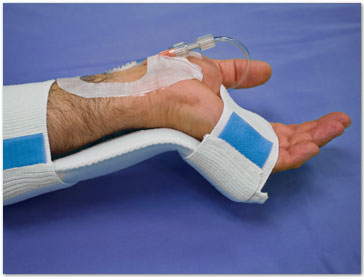Once you are sure the IV is patent, it is important to secure the catheter to avoid movement within the vein causing trauma, and to prevent the catheter from pulling out of the body. While the securement method described here has been proven to be effective, your facility may have some variations. Always use the methods prescribed by the facility.

To protect the skin, place a gauze pad or small piece of foam tape beneath the hub of the catheter. This will reduce the pressure exerted upon the patient’s skin. If the gauze becomes wet or soiled, you will need to replace it as soon as possible.
Next, cover the wound you made. A transparent dressing over the site of venipuncture is preferred, as this allows you to monitor the site for inflammation and infiltration. An edge of the dressing should extend to secure the lip of the hub of the catheter securely to the body. The connection between the hub and tubing should be left free to facilitate removal and replacement of the tubing.
Then, secure the hub with adhesive tape. Leave the insertion site visible. Do not tape over the connection between the tubing and the hub. Also, be sure not to wrap the tape around the entire circumference of the limb, as this will impair circulation in cases of edema.
Finally, secure the line. Place a piece of tape over the IV line, about 1 inch away from the connection to the hub. Loop the tubing at least once and secure the loops to the skin with tape. If the patient becomes restless, these loops will pull out before the entire line dislodges and needs to be reinstalled.
If the patient is diaphoretic, the tape may not stick well to the skin. In this case, apply the transparent dressing and then use a roller gauze to secure the line to the patient’s limb. Be careful not to roll the gauze too tightly to avoid reducing circulation in that limb. Secure the loops as well, trying to keep the transparent dressing exposed for easily visualization of the IV site.
For younger patients and those who present restless or confused, there is an increased risk of dislodgement. You may consider the use of an armboard to protect the IV line. Armboards are usually made of a heavy cardboard material that is padded with foam and are available in various lengths. Most armboards are designed for single use, so dispose of it after the patient’s infusion is discontinued.

Understand, however, that arm boards are not the first choice in care, and should be avoided when possible since they may interfere with joint motion. If an arm board is necessary, use one that will be long enough to protect the IV line but short enough so the patient can maintain maximum mobility. Secure the arm board to the patient’s arm by wrapping roller gauze loosely around the arm board and the patient’s arm. Again, leave the insertion site uncovered for easy inspection.
An arm board should be periodically removed to allow for joint movement and prevent stiffness. This is also a good opportunity to assess the extremity for skin irritation, discomfort, infiltration and any impairment to circulation.
